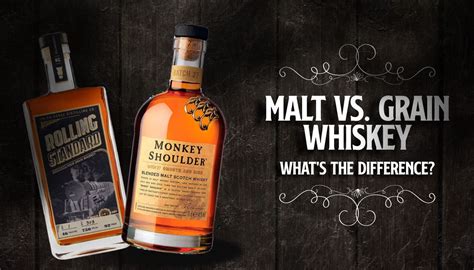single grain vs single malt,Malt whisky vs. grain whisky – what’s the difference? ,single grain vs single malt, Single grain whiskies are made from wheat, corn, or a blend of both. These can also be malted or unmalted. The resulting whiskies are usually lighter and sweeter than their single malt siblings. Discover Fendi’s latest luxury Clutches & Pochette for Women, blending the Maison's daring creativity and craftsmanship. Shop now on Fendi.com. . The Iconic Baguette Bag NEW; Fendi Fur NEW; Fendi Selleria Since 1925 ; News . Miami Design District Boutique ; Fendi Ho Chi Minh City ; Fendi sponsors Louise Bourgeois. Unconscious MemoriesTo share with you the small differences from the dupe of the Amazon Fendi First compared to the Authentic Fendi First. So, I hope this video gives you the differences of both handbags.

Scotch whisky is one of the most iconic beverages in the world, and within this legendary category, two types often take center stage: single malt and single grain whiskies. While single malt whisky is perhaps Scotland’s most famous export, single grain whisky is quickly making a comeback, earning recognition and respect among whisky connoisseurs and casual drinkers alike. But before diving into the world of Scotch whisky, it’s important to understand what differentiates these two categories of whisky, what each term means, and why these distinctions matter to the flavour, production, and enjoyment of the drink.
In this comprehensive guide, we’ll explore the differences between single malt and single grain whiskies, breaking down everything from their definitions to their production processes and the impact this has on the whisky’s taste. By the end, you’ll be equipped with all the knowledge needed to fully appreciate these two distinct types of Scotch whisky.
What Is Single Malt Whisky?
Defining Single Malt Whisky
To understand single malt whisky, we first need to examine what makes a whisky “malt.” Malt whisky is made primarily from barley, a grain that is malted through a process of soaking, germination, and drying. When it comes to single malt whisky, the term "single" refers to the whisky being made at a single distillery, from a single batch of malted barley.
In other words, single malt whisky is a product of a single distillery that uses only malted barley as the primary grain, and the whisky is produced through traditional methods, usually involving pot still distillation. This process leads to a full-bodied and complex spirit, often characterized by a rich array of flavours.
Key Characteristics of Single Malt Whisky
- Ingredients: Malted barley is the sole grain used in the production process.
- Distillation Process: Typically distilled in pot stills, which allows for more flavour retention compared to column stills.
- Geography: The whisky must be distilled in Scotland to legally be called Scotch whisky.
- Single Origin: Produced in a single distillery from a single batch of malted barley.
Flavour Profile
Single malt whiskies are known for their complexity and depth of flavour. The character of a single malt is influenced by many factors, including the type of casks used for maturation (usually oak), the distillery’s location, and the specific methods employed during distillation. The whisky’s flavour can range from light and floral to deep and smoky, with common tasting notes including honey, dried fruit, vanilla, peat, and spices.
What Is Single Grain Whisky?
Defining Single Grain Whisky
Single grain whisky is often misunderstood. For many years, it was thought to be an inferior whisky, relegated primarily to blended whiskies. However, in recent years, single grain whisky has begun to receive more attention as producers experiment with different grains and maturation techniques.
Like single malt whisky, single grain whisky is made in a single distillery, but it is not made exclusively from malted barley. Instead, it can be produced from a combination of different grains, including wheat, corn, and rye. Additionally, single grain whisky is typically distilled using a column still, which allows for higher yields and a lighter, smoother spirit compared to pot stills used for malt whiskies.
Key Characteristics of Single Grain Whisky
- Ingredients: Made from a mixture of grains, which can include wheat, corn, or even barley.
- Distillation Process: Typically distilled using continuous column stills, which produce a lighter and cleaner spirit.
- Geography: Like single malt whisky, it must be made in Scotland to be called Scotch whisky.
- Single Origin: Produced in a single distillery but with a wider variety of grains used in the production process.
Flavour Profile
Single grain whiskies are known for their smoother, lighter profile compared to single malts. Since they are produced from a variety of grains and distilled in column stills, they tend to have a cleaner, less intense flavour. Tasting notes for single grain whiskies can include sweetness, vanilla, caramel, and subtle notes of spice. Although lighter than their malt counterparts, they can still be complex, with some expressions offering hints of oak, fruit, and nutty undertones.
The Difference Between Single Malt and Single Grain Whisky

1. Ingredients
The most fundamental difference between single malt and single grain whiskies lies in the ingredients.
- Single Malt Whisky is made from 100% malted barley.
- Single Grain Whisky, on the other hand, can include other grains like wheat, corn, and rye, in addition to barley.
single grain vs single malt

single grain vs single malt These Cult Gaia Ark bag look alikes stand out as stylish, eco-friendly options, perfect for anyone on a budget. The handmade construction and natural bamboo material offer unique, bohemian looks that are both functional and fashionable.
single grain vs single malt - Malt whisky vs. grain whisky – what’s the difference?





















































